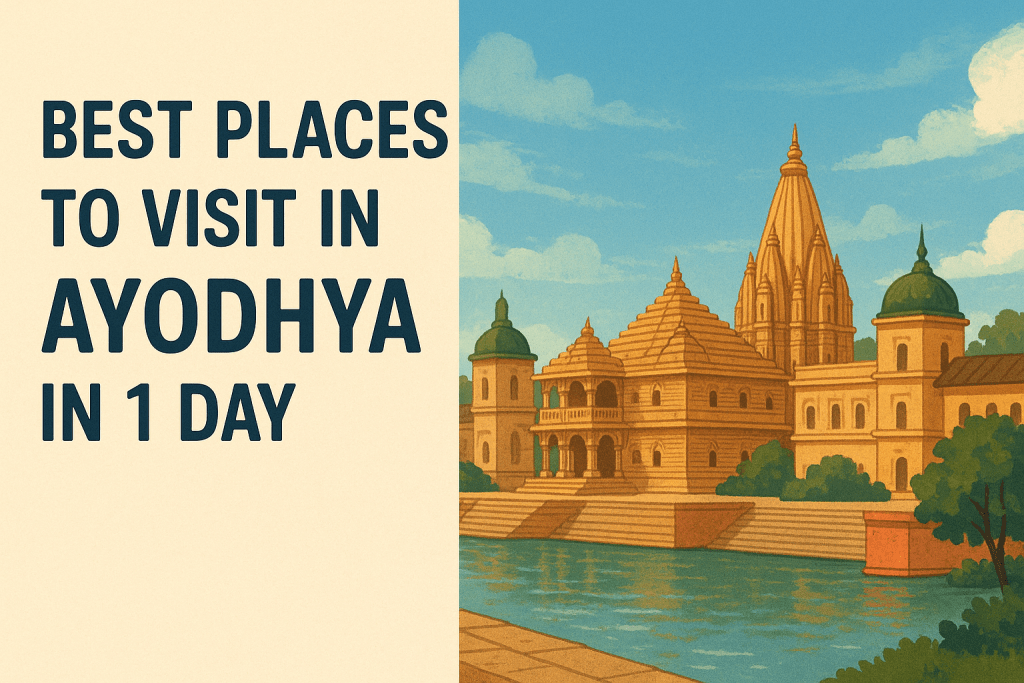Ayodhya has a unique cultural and religious identity. Its serene and spiritual atmosphere helps devotees strengthen their devotion to the divine. And as the birthplace of Sri Ram, it is visited by millions of devotees every year. With limited time in one of India’s holiest cities, are you worried about how you’ll plan your Ayodhya trip? In this guide, we help you choose the top places to visit in Ayodhya in 1 day.
Top Places to Visit in Ayodhya in 1 Day
You can cover many of the major attractions of Ayodhya in just 1 to 2 days. For a 1-day trip to Ayodhya, you can focus on visiting the following places:
1. Hanuman Garhi
Timings: 5 AM to 11 AM, 4 PM to 11 PM
Entry Fee: Free
Hanuman Garhi Mandir is often the first place devotees visit on a trip to Ayodhya. It is believed that Lord Hanuman lived here and protected Ayodhya from this hill. Visit the temple to seek his permission, blessings, and protection before visiting Ram Janmabhoomi. It is not very crowded early in the morning but it can get busier later in the day.
You need to walk for some time from the main road and then climb 76 steps to reach the main shrine. If it’s crowded, you can also use the back stairs. You can leave your shoes at any of the shops you buy prasad from or pay beggars to keep an eye on them.
2. Shri Ram Janmabhoomi Mandir
Timings: 7 to 11:30 AM, 2 to 7 PM
Entry Fee: Free
In your list of places to visit in Ayodhya in 1 day, let this mandir be your number 1. The Shri Ram Janmabhoomi Mandir is built on the place where Lord Rama was born. It is one of the most significant religious monuments in Ayodhya and a spiritual and architectural delight. The temple is generally less crowded in the mornings and after 6.
You are not allowed to carry personal belongings such as electronics, purses, belts, smart watches, car keys, etc., inside. You can deposit such items in the lockers that are provided free of charge. However, if the temple is crowded, the lines to the locker rooms will be very long. To avoid any delays, keep non-permitted items at your hotel or in your transport vehicle.
3. Kanak Bhawan
Timings: 8 AM to 11 AM, 4:30 PM to 9 PM
Entry Fee: Free
It is said that this palace was a gift from Kaikeyi to her daughter-in-law, Sita. the building features Bundela-style architecture, paintings, and heavily decorated idols of Lord Rama and Sita with gold crowns.
The temple is open for limited hours each day and is very close to Hanuman Garhi Mandir and Dashrath Mahal. Take care of your belongings, as you may come across large groups of monkeys outside.
4. Ram ki Paidi and Saryu River
Timings: Open 24 Hours
Entry Fee: Free
This series of ghats along the Saryu river is famous for its religious and cultural significance. Here, devotees can take a dip in the holy river and view the beautiful scenery. During Diwali, the ghats are crowded and filled with devotees from all over the world, who come here to witness the mass lighting of diyas in the evening aarti.
Every evening, an aarti is performed on the banks of the Saryu river at 6:30 PM. This is one of the most soulful and spiritual aartis one can experience in their lifetime. The glowing of diyas floating in the river, the chanting of mantras, temple bells ringing, and the small crowd of devotees united by their devotion. Sunrise and sunset are the best times to visit the river.
5. Visit Local Markets
If you have time, you can visit the local markets around Ram Path and Rekabganj. Everywhere, you will find shops selling delicious vegetarian snacks, meals, and sweets. Pick up souvenirs like wooden carved idols, religious items, incense, handicrafts, etc.
FAQs
You can buy VIP darshan passes from the Ram Janmabhoomi trust office. These passes are available through prior booking online or from the temple counter.
You can choose to take a dip in the Saryu River, go on a boat ride or a stroll along the riverside, or attend the evening aarti at the ghats.
It is believed that the devotee must first bathe in the Saryu river, then visit Hanuman Garhi temple to take permission from Hanumanji, and finally visit the Ram Janmabhoomi Mandir.
While there is no strict dress code for Ram mandir, you are expected to wear respectful and modest clothing. Avoid wearing shorts, sleeveless tops, tight or sheer clothing, and flashy colors. We recommend that both men and women should wear traditional clothing such as a dhoti and angavastra for men and a saree or salwar kameez for women.
Yes, because they are close to one another, you can visit the Ram Janmabhoomi Mandir as well as other important temples and holy places in Ayodhya in a single day.



